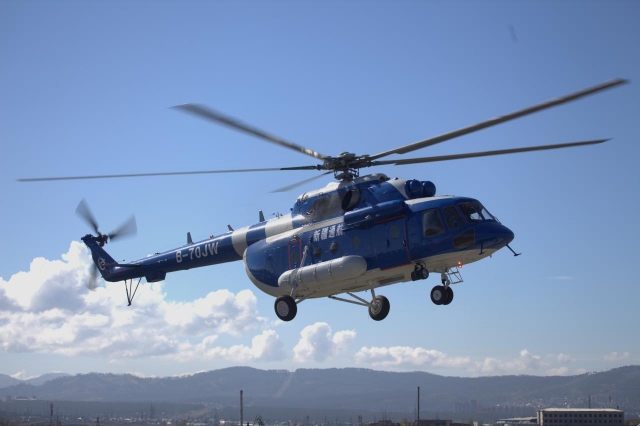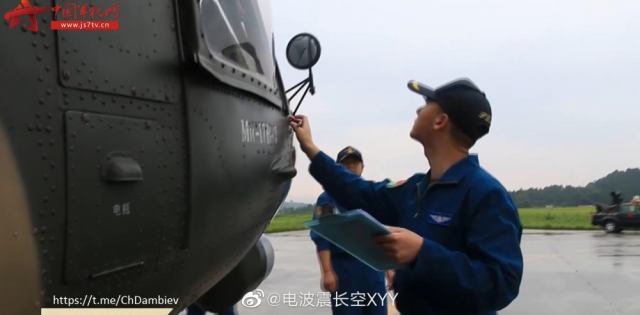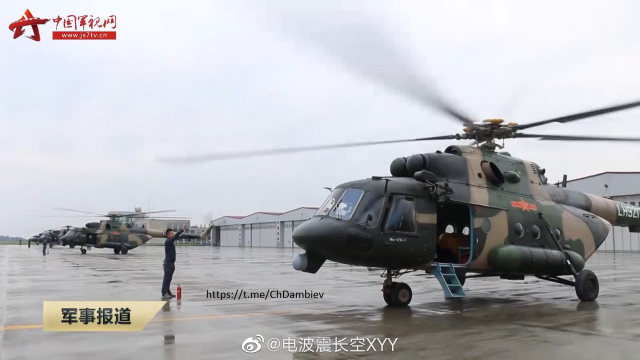New Mi-17V-7 helicopters for the PLA Army Aviation
A video spot released on the js7tv.cn website of the state-owned China Central Television 7 (CCTV 7) channel reveals newly delivered Mi-17V-7 multipurpose helicopters entered service with the People's Liberation Army Aviation. The helicopters, supplied by the Kazan Helicopters plant of the Russian Helicopters holding (part of the Rostec State Corporation), are equipped with VK-2500-03 power plants manufactured by JSC UEC-Klimov based in St. Petersburg (Russia). This company is part of United Engine Corporation, which is a branch of JSC Rostec State Corporation.
At the same time, Russian helicopters equipped with the VK-2500-03 engines have also started to reach their first civilian clients. On 9 September 2020, JSC Russian Helicopters circulated a press release about their first Mi-171 helicopters with the VK-2500-03 engines delivered to the Chinese civil aviation airline Xinjiang General Aviation Co., Ltd. The helicopters, registered B-70JV and B-70JW, have been assembled at the Ulan-Ude Aviation Plant of the Russian Helicopters holding (part of JSC Rostec) and took part in the test programme to issue a CCAR-91 national type certificate for the Mi-171 helicopter with this power plant. The decision of the PRC aviation authorities has expanded the capabilities of the Russian Helicopters holding to meet the needs of the Asian market.

Compared to the TV3-117VM series 02 engines used on the Mi-17V-5/Mi-171E versions, the use of VK-2500-03 engines with higher thrust-to-weight ratio provides various advantages, including increased high-altitude flight power with higher static and dynamic flight ceiling, improved carrying capacity in the cargo hold or on the external sling and better emergency response times. In addition, the available engine power in emergency flight mode results in increased operational safety in the mountainuous regions, as well as improved flight safety with just one running engine. At the same time, the BARK-78 digital automatic regulation and control system makes it possible to improve the accuracy of engine control in all modes of operation.
To clarify the currently ongoing “war on engines” between Russian and Ukraine, Scramble Magazine can provide further details. After the collapse of the Soviet Union, Ukrainian Motor-Sich enterprise was the company which turned out to be holder of the entire documentation for the TV3-117 engines under the original name. For many years, Russian Armed Forces have been a primary customer for the production of the Zaporizhia-based production plant, buying 250-270 engines annually from Ukraine, with their own UEC-Klimov only being a developer bureau with very limited annual production capacity of 50-60 engines a year. After the 2014 revolution in Kiev, Russian aerospace industry has launched a large-scale import substitution programme in order to eliminate the dependency on Ukrainian manufacturers and Russia’s United Engine Corporation UEC-Klimov has been chosen to replace the Motor-Sich with the re-issued documentation for the VK-2500/VK-2500PS engine, which represents an advanced Russian version of the TV3-117 with a full-authority digital engine control system.
The sudden rise of presence of helicopter engines assembled by UEC-Klimov is therefore by no means a surprise. Between 2018 and 2020, the St. Petersburg-based enterprise has been performing a large-scale reconstruction of its testing facilities. The amount of over 2 billion rubles from the funds of Rostec has been invested to build 27 test benches for different engine types (three for turbofans, six for helicopter turboshafts, two stands for turboprops and sixteen for engine components such as aggregates or turbine starters). The management of JSC UEC-Klimov expects that the new testing facilities enable increase of the production of VK-2500/VK-2500PS engines for helicopters by further 30%.
In 2019, the total production output of the UEC-Klimov was around 230 engines of the VK-2500/TV3-117 type, powering Mi-28N, Ka-52, Mi-35M and Mi-24 combat helicopters, as well as the Mi-17/Mi-171 and Ka-27/32 family. The supply of spare parts accounted for production of an additional 150 units, with steadily decreasing share of imported parts. Nevertheless, at least part of the production has still had to be outsourced to Ukraine, as the documents show. In 2019, Motor-Sich exported 70 turboshaft engines for civil aviation, without installed aggregates, designated as VK-2500-03, worth USD 25.7 million, to the Latvian Riga-based company SIA AEROSERVICE, for subsequent re-export to the Russian Federation. These engines were then most likely completed at UEC-Klimov for installation on helicopters destined for export or as spares to UEC’s extensive network of servicing nodes including logistics support centers in Vietnamese city of Vũng Tàu and near the city of Arequipa (Peru).

Photos via js7tv.cn and Russian Helicopters


